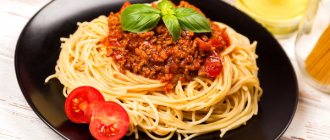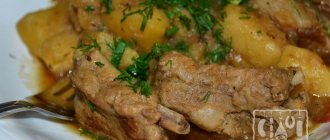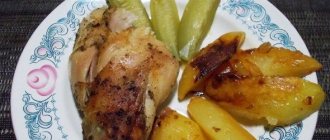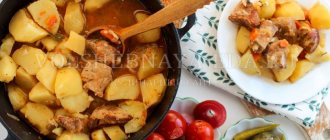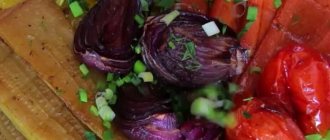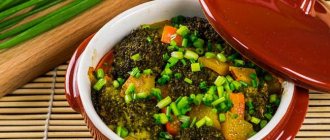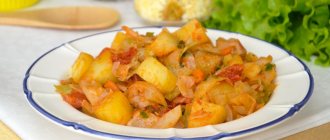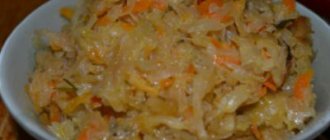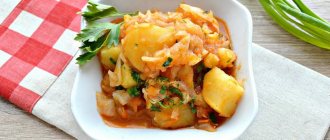Cooking steps
Peel the eggplant, cut into small pieces and fry in vegetable oil directly in the pan in which you will cook the vegetables.
Cut the zucchini into small pieces.
When the eggplant is sufficiently fried, add the zucchini pieces to the pan.
Fry for 7 minutes.
Cut the potatoes into small pieces.
Add potatoes to the pan.
Grate the carrots on a coarse grater, chop the onion into small pieces and fry in a frying pan in vegetable oil.
Fry until lightly browned.
Then add tomato paste and continue frying until almost cooked.
Add the fried carrots and onions to the pan with the rest of the vegetables.
Add hot water, salt and pepper. The amount of water for stewed vegetables depends on your choice (whether you want it thinner or thicker). You can add some herbs (fresh or dried).
After adding water, simmer the vegetables for 10 minutes, then turn off the heat and you can start taking samples.
Bon appetit!
Good afternoon friends!
Today we are preparing vegetable stew according to the most delicious recipes. It can be prepared from any vegetables at your discretion, and you can vary the number of ingredients. This is a universal dish; it can be served as a second dish or a side dish with meat.
Stew recipes are interesting because the base of the dish is the same for all - chopped stewed vegetables, and the additives to them can be very different: meat, mushrooms, seafood, legumes. The cooking methods are also interesting - you can simmer in a frying pan, bake in the oven, or, as has become fashionable recently, cook in a slow cooker.
Have you ever cooked this dish? How did it turn out for you?
Each vegetable has a different cooking time. How to make sure that in the final product it retains its shape, hardness and biological value, and does not turn into caviar. Read on, I’ll tell you more about this later.
Vegetable stew recipe
I love autumn for its abundance. I look at the beds and rejoice at the colors and variety of the grown crop. I get inspired for culinary exploits, and the first thing that comes to mind is vegetable stew. Let's cook it together, improvise and add everything we have to the dish.
Ingredients:
- onions - 2 pcs.
- carrots - 2 pcs.
- zucchini - 1 pc.
- potatoes - 2 pcs.
- eggplants - 2 pcs.
- olive oil - 2 tbsp. l.
- bell pepper - 2 pcs.
- garlic - 4 cloves
- green hot pepper
- bay leaf - 2 pcs.
- apple cider vinegar - to taste
- seasonings: oregano, basil - bunch
- greens: parsley, dill - bunch
- salt - to taste
- sugar - to taste
- chicken broth - 100 gr.
Preparation:
Simple rules to follow when preparing stew:
- chop all vegetables fairly large
- place food only in a hot frying pan
- fry until half cooked
- lay in a certain sequence
- add salt only at the end of cooking
Place the frying pan on the fire and add oil.
Cut the onion into large squares; it will stew well during the cooking process. When the oil is warm, add the onion to the frying pan. After 2 minutes it becomes transparent.
Grate the carrots on a coarse grater and combine with the onion, mix, cover with a lid, and leave on low heat.
Cut the potatoes into medium cubes and add them to the frying pan with the carrots and onions.
It is better to take yellow bell peppers. Beautiful color scheme gives an aesthetic appearance to the dish and increases appetite. Peel the pepper from seeds and cut into medium slices. We send it to the frying pan.
Cut off the tail of the eggplant and cut into medium rings. If it turns out to be bitter, chop it up and put it in a bowl, salt it well and leave for 20 minutes. It will release juice, it must be drained and the bitterness will go away along with the juice. We will fry the eggplants in another frying pan.
Cleaning the young zucchini. If you get caught with seeds, remove them with a spoon. Cut into larger pieces and add to the vegetable mixture. Add a little salt and mix.
To make the stew juicy, add 100-150 grams of chicken broth.
Add stewed eggplants there.
Chop the young white cabbage and simmer for 7 minutes.
Peel the tomatoes. To do this, dip them in boiling water for a few seconds and immediately under cold water. The peel is easily removed. We chop and wait until the cabbage is stewed and only then add the chopped tomatoes.
If there is no tomato, you can add tomato juice or paste.
Peel the garlic, mash it with the flat side of a knife and chop it. Crushed garlic imparts its taste and aroma to the dish faster.
Add your favorite seasonings. I take oregano, basil, a little fennel.
Vegetable stew - recipe with potatoes, zucchini, cabbage and eggplant
This is one of the simplest and most delicious recipes. I make this dish all summer, changing ingredients as new vegetables ripen. Low in calories, rich in vitamins and easily digestible, it is well suited as a side dish to any meat.
Ingredients:
- onion - 2 pcs.
- carrots - 2 pcs.
- zucchini - 2 pcs.
- potatoes - 2 pcs.
- eggplants - 2 pcs.
- cauliflower - 1 pc.
- chicken broth - 150 gr.
- olive oil - 2 tbsp. l.
- garlic - 4 cloves
- seasonings: oregano, basil, bay leaf - to taste
- greens: parsley, dill - to taste
Preparation:
- Cut the carrots and onions into medium squares and sauté in a small amount of oil.
- Cut the potatoes into slices and fry.
- Boil the cauliflower and separate it into individual pieces.
- Boil green beans.
- Combine all the vegetables except cabbage in a deep frying pan, pour in 100 grams of broth and simmer.
- 10 minutes, add diced zucchini and simmer for another 10 minutes.
- At the end of the stew, add the stewed cabbage, add crushed garlic, bay leaf, and spices.
- When serving the stew, generously sprinkle with herbs.
Stewed potatoes
Potatoes are stewed whole, selecting medium-sized tubers, or cut into slices and large cubes. The prepared potatoes are fried, placed in a kettle or pan, poured with the main red sauce and simmered under a closed lid until cooked. During the stewing process, add sautéed onions, and 5-7 minutes before readiness, add bay leaves and peppercorns. Season the finished potatoes with salt to taste. Serve it on a plate or in a lamb, sprinkled with chopped herbs.
Stewed potatoes are served as a side dish for stewed meat. It can be stewed without sauce with fat, tomato and a small amount of broth, as well as with mushrooms, prunes and other products.
A simple recipe for vegetable stew with meat in a slow cooker
Using kitchen appliances frees you from spending a long time in the kitchen. This results in a stew with soft and juicy meat, tasty potatoes and cabbage. Cooking time 1 hour.
Ingredients:
- beef meat - 500 gr.
- potatoes - 1000 gr.
- onion - 2 pcs.
- carrots - 2 pcs.
- white cabbage - 300 gr.
- tomato paste - 1 tbsp. l.
- vegetable oil - 2 tbsp. l.
- salt, spices - to taste
Vegetable stew with chicken and potatoes
This is one of the best recipes for vegetable stew with meat. It turns out to be a light, satisfying, budget dish. Also attractive is the large selection of available ingredients and the speed of preparation.
Ingredients:
- chicken breast - 500 gr.
- onion - 2 pcs.
- carrots - 2 pcs.
- zucchini - 1 pc.
- potatoes - 500 gr.
- vegetable broth - 150 gr.
- olive oil - 2 tbsp. l.
- garlic - 4 cloves
- seasonings: basil, bay leaf - to taste
- tomato sauce - 1 tbsp. l.
- black peppercorns - 6-8 peas
- greens: parsley, dill - to taste
Preparation:
- Cut the chicken breast fillet into medium pieces and fry in olive oil in a cauldron until half cooked, for 10-15 minutes.
- Select medium-sized potatoes, peel and cut in half. Fry in boiling oil until golden brown. Place in a cauldron with meat.
- Cut young carrots into medium rings. If it is rough, then it is better to grate it on a coarse grater. Peel the onion and use medium half rings. Mix both ingredients and simmer lightly, then add to the meat and potatoes.
- If desired, add cabbage and green beans. Boil them in a small amount of salted water and send them to the cauldron.
- Add finely chopped garlic, black peppercorns, bay leaf, basil sprigs, tomato sauce, and salt.
- Fry two tablespoons of flour in a frying pan and dilute with the vegetable broth in which you cooked the cabbage and beans.
- Mix everything carefully, pour in the broth, close the lid and simmer for 20-30 minutes over low heat.
- Place the finished stew with chicken on a large dish, sprinkle with chopped dill and parsley on top. Bon appetit!
LiveInternetLiveInternet
Vegetable dishes are the basis of any healthy diet, and in the diet of children and expectant mothers, vegetables should account for at least 50 percent of the total food. Stewing vegetables helps you quickly and easily get in one “cooking session” both an independent full-fledged dish, a gravy for a side dish, and a base for a meat stew. But you need to stew vegetables correctly.
Classic stewing of vegetables occurs in water or broth, but you can diversify the autumn diet menu and stew vegetables in sauce, wine or beer. A simple and popular dish of a mixture of vegetables - stew - is prepared from what is found in the refrigerator - potatoes and carrots, onions and turnips, green peas and cabbage, root vegetables, fruits, herbs. Gourmets add meat to the stew, while vegetarians and those who want to lose weight make a low-calorie vegetable stew.
Before stewing, vegetables must be thoroughly rinsed under running water, then peeled, rinsed again in cold water and cut into slices, cubes or cubes. Healthy nutrition experts recommend washing vegetables in enamel or aluminum dishes, and for slicing, take plastic or glass cutting boards and use a special grooved knife for cleaning, and stainless steel knives for slicing vegetables.
Vegetables should be peeled immediately before cooking so that they do not lose their flavor and some of their nutrients. To make stewed vegetables a success, maintain a constant temperature - on the stove it should not exceed 82 degrees, and in the oven - 170. Vegetables should simmer in a liquid that is barely boiling.
Choosing vegetables
Eggplants, zucchini, onions, potatoes, tomatoes, asparagus and mushrooms are ideal for stewing. Experienced housewives stew potatoes with sweet peppers, prunes, raisins, and in the fall - with pumpkin. Carrots are also stewed with prunes or honey, which is perfect for sweet dishes. The most popular vegetable for stewing all year round is cabbage; it is an excellent side dish for meat cutlets and fish and an excellent filling for homemade pies.
Some cooks recommend poaching before stewing, that is, cooking in its own juice or in a small amount of water. Vegetables
placed on the bottom of the dish in one row, the thickness of the layer should not exceed 15-20 cm, close tightly with a lid and simmer at a low boil until half-cooked, and after that the stewing process begins. Often, when preparing a dish from prefabricated vegetables, each vegetable is simmered separately and then combined.
Autumn recipes
Stewed eggplant
You will need 2 eggplants, 1 tbsp. spoon of flour, 1 glass of sour cream, 2 tbsp. spoons of butter. Cut the eggplant into slices and place in hot salted water for five minutes, then drain in a sieve or colander, drain, roll in flour and fry. After this, put the eggplants in a saucepan, pour in sour cream and simmer for about half an hour.
Braised cabbage
Take 1 kg of cabbage, 2 onions, 2 tbsp. spoons of tomato puree, 1 tbsp. spoon of vinegar, 1 tbsp. spoon of sugar, 1 tbsp. flour, 3 tbsp. spoons of butter.
Shred the cabbage, place in a saucepan, add 1 tbsp. a spoonful of butter, 0.5 cups of water or meat broth, cover with a lid and simmer for 40 minutes. Add the fried onion, tomato puree, vinegar, salt, bay leaf, pepper and continue to simmer until tender for about 10 minutes. When the cabbage is ready, put the flour fried with butter into the pan, stir and boil. If you are stewing sauerkraut, do not add vinegar.
Vegetable stew
Take 500 g potatoes, 3 carrots, 2 turnips, 2 onions, 2 tomatoes, 3 tbsp. spoons of butter, tbsp. a spoonful of flour, 2 cups of meat broth. Cut the vegetables into cubes or slices, simmer the carrots and turnips until tender, fry the potatoes and onions in a frying pan with butter. Separately, fry the flour in a frying pan, dilute it with the broth from the stewed vegetables, add finely chopped tomatoes and boil. Pour the prepared sauce over the vegetables placed in one pan, add salt, pepper, 3-4 pcs. cloves, a piece of cinnamon, cover the pan with a lid and simmer the vegetables for 15-20 minutes.
Bon appetit!
Zoya Maksimova
Source
I'M WAITING FOR YOUR FEEDBACK!
How to cook vegetable stew in a saucepan
Any vegetable except cucumber will do for this simple recipe. The result is a light, low-calorie, but very tasty dish.
Ingredients:
- zucchini - 1 medium size
- carrots - 2 pcs.
- onions - 2 pcs.
- sweet bell pepper - 1 pc.
- tomatoes - 2 pcs.
- garlic - 2 cloves
- salt, pepper - to taste
That's probably all. Thank you for reading to the end. Stay tuned for new recipes.
Vegetables contain a large amount of vitamins and microelements, without which it is unthinkable to maintain health and well-being. Their benefits for weight loss largely depend on the method of preparation.
Eating raw is an excellent option, but stewed vegetables are no less useful for weight loss. When cooked with steam or water, they do not lose vitamins, and the dish will not have time to get boring, since you can stew them in various sauces.
Frying is considered the most harmful option; it increases the fat content of the dish due to the use of oil, and carcinogens are produced.
Benefits of stewed vegetables:
- Cooking without oil provides low energy value.
- During heat treatment, fruits do not lose fiber, which helps cleanse the body and quickly saturate it.
- The high content of vitamins and beneficial microelements has a beneficial effect on the body during the diet.
- Low carbohydrate content, so the liver is not overloaded, and weight loss occurs faster.
Rules for stewing vegetables for weight loss:
- You can prepare healthy dishes in a variety of ways: in a slow cooker, steamer, microwave, or on the stove.
- It is important to choose the right cookware. The ideal solution would be a pan with a thick bottom. It is recommended to choose steel from materials.
- For better processing of vegetables, you should simmer them under the lid. As for the fire, it does not need to be made too strong, just slow.
- To preserve vitamins in vegetables, it is necessary to observe their cooking time. You should simmer for no longer than 40 minutes, then the beneficial substances will disappear.
- Before cooking, you need to finely chop the cabbage. The remaining vegetables (zucchini, tomatoes, eggplants, carrots) are cut into medium-sized cubes. It is recommended to use stainless steel knives, which will prevent oxidation processes in products.
- It is best to simmer in water without adding oil. But water, completely covering the vegetables, can help wash away the beneficial components. When stewing, the fruits themselves will begin to release juices. And you shouldn’t give up water completely: if there is no water or insufficient quantity, there is a risk that the food will burn.
- If you cannot purchase fresh products, you can prepare frozen ones. But before you start stewing, you need to wait until the vegetables thaw naturally.
How to properly stew vegetables in a frying pan and in a saucepan?
Stewed vegetables can be either a main hot dish or an excellent side dish for meat or fish delicacies. Stewed vegetables can always be prepared in different ways . Just add a new seasoning or a delicious sauce, and the vegetable mix will sparkle with a new taste. That is why vegetable stew is an absolute find for every cook.
The good news is that almost all representatives of vegetable groups can be stewed. Vegetables go perfectly together, both fresh and frozen. However, you should take into account the fact that vegetables have different cooking times. For example, tomatoes should be added much later than cabbage or radishes. And if the recipe includes ingredients such as beans or beans, then they are prepared in advance, only then added to the vegetables.
Herbs will help decorate the dish or add a piquant taste : dill, parsley, mint, bay leaf, savory, lemon balm and basil.
Methods for stewing vegetables
The taste of stewed vegetables directly depends on the cooking method: they can be stewed in a frying pan, in cast iron pots in the oven, in a slow cooker or over an open fire.
When choosing a method, you should focus on personal taste preferences, because each option has advantages and disadvantages.
Stewing in a frying pan. For this method, vegetables require pre-frying. Stewing in a frying pan is suitable for preparing a small number of servings. Many people prefer this method due to the speed of preparation. Vegetables acquire a golden color and juicy taste. There are only three drawbacks: there is a high probability of burning, constant stirring and control of moisture evaporation are necessary.
baked in the oven in their own juice will undoubtedly delight the whole family. In ceramic or clay dishes, vegetables are imbued with an unsurpassed aroma. In pots, dishes are divided into portions and are ready for original serving. There is also a minus: cooking will take much longer compared to the previous method.
When choosing a cooking method over an open fire , you should prepare for a long wait. However, it will be justified by an incomparable result. Thanks to the thick walls of cast iron cookware and a tight lid, vegetables will not burn, and the taste will be excellent .
A slow cooker is a salvation for everyone. Advantages of a multicooker: does not require any control, fast cooking and rich aroma. In addition, steaming helps to maximize the preservation of vitamins and nutrients. The only drawback is the possible dullness of the prepared vegetables. However, this can easily be eliminated by adding your favorite sauces and herbs.
General recommendations on how to properly stew vegetables
Vegetables should be washed and peeled immediately before cooking . This will preserve all the beneficial properties, vitamins and natural aroma. Cut vegetables as desired: into cubes, cubes, circles or strips.
Constant monitoring of the extinguishing temperature is necessary. It shouldn't change . For the oven, no more than 170 degrees; for the stove, it should not exceed 82. That is, the released juice should barely boil.
Pre-cooking the vegetables in their own juice or a small amount of liquid will improve the taste of the dish. That is, you should let . Moreover, each vegetable is cooked separately. To do this, pour water into the pan, place vegetables in one layer, close tightly and simmer at the optimal temperature (85-90 degrees) for about 10-15 minutes.
How to properly stew vegetables in a frying pan or in a saucepan?
Vegetable stew is everyone’s favorite and unpretentious dish. The ability to cook differently every time is its main advantage. You just need to change the ingredients, seasonings or cutting form. Any vegetables that are available are suitable for cooking. It all depends on the time of year: tomatoes, zucchini, pumpkin, carrots, potatoes, all varieties of cabbage, onions, sweet peppers, etc. It is possible to use frozen vegetables.
Ingredients:
- half a kilogram of potatoes; - 2-3 carrots; — turnip — 2 pcs. (you can take rutabaga); — onions — 2 pcs.; — tomato — 2 pcs. (if not available, should be replaced with tomato paste); - 300 grams of cabbage; - beans as desired (the ratio of beans to vegetables is 1:4).
Vegetables are chopped into strips or cubes to the desired size. The cabbage must first be half cooked separately (simmered in a small amount of water). Fry the potatoes in a frying pan along with the onions, also until half cooked.
Next you need to prepare the spicy sauce . The simplest version of the sauce: fry a spoonful of flour in a heated frying pan, poured with oil. Next, add a little vegetable broth or water (about 300 ml), chopped tomato or tomato paste. Bring everything together to a boil.
Place raw eggplants and carrots, poached cabbage and fried potatoes in a container (saucepan or deep frying pan) and pour in the prepared sauce. To enhance the taste, add salt and pepper. The ideal spice is cloves. Simmer under a tight lid on the stove or in the oven for 20 minutes over low heat. It is necessary to ensure that
The benefits of stewed vegetables for weight loss
Many diets are based on avoiding junk food and replacing it with healthy foods. Vegetables are perfect for this role. The gifts of nature contain a large amount of vitamins and microelements, without which it is unthinkable to maintain health and well-being.
The benefits of vegetables for weight loss largely depend on the method of their preparation. Eating fruits raw is always welcome, but you can also serve various dishes based on them. It is believed that stewed vegetables are especially suitable for weight loss.
Nutritionists recommend that those who want to get in shape should pay attention to the way they prepare foods. Frying is considered the most harmful option, since oil increases the fat content of the dish and also produces carcinogens. Therefore, it is better to process foods, including vegetables, using steam or water.
Braising allows you to preserve the beneficial properties of food. Vegetables prepared in this way lose almost no vitamins they contain. And you won’t have time to get bored with the dish: you can stew it in various sauces.
This method of preparation allows you to preserve the benefits of the product as much as possible. Stewed vegetables are recommended for weight loss for the following reasons:
- Small amount of calories. Cooking vegetables without oil provides low energy value.
- Fiber content. During heat treatment, fruits do not lose this substance, which helps cleanse the body and quickly saturate it.
- High content of vitamins and beneficial microelements. They also don’t go anywhere when stewing.
- Low carbohydrate content. Thanks to this, the liver is not overloaded, and weight loss occurs faster.
And here is more information about a meat-free diet for weight loss.
DISHES AND SIDE DISHES FROM STEWED VEGETABLES
⇐ PreviousPage 2 of 2
Stew each type of vegetable separately or together - a mixture of vegetables. Before stewing, vegetables are cut into strips, cubes, slices, then fried until half cooked or simmered, after which they are stewed with a small amount of broth or sauce with the addition of tomato puree, sautéed vegetables, bay leaf, and pepper. It is allowed to use fresh or sauerkraut for stewing without preliminary heat treatment. Stew vegetables in a container with a closed lid at low boil.
Stewed cabbage
. Fresh cabbage, chopped into strips, is placed in a cauldron in a layer of no more than 30 cm, a small amount of broth or water and fat are added and simmered first over high heat, and when it warms up and settles a little, reduce the heat. Simmer, stirring occasionally, until half cooked, then add sautéed carrots, onions, parsley, tomato puree, add bay leaf, pepper and continue to simmer. At the end of the stewing, add vinegar, flour sauté diluted with water or broth, salt, sugar and bring to readiness. If stewed cabbage is prepared from mid-season and mid-late varieties, then vinegar is added at the beginning of stewing. When using sauerkraut, vinegar is excluded from the recipe, and the sugar level is increased to 10 g per serving.
If you prepare stewed cabbage with lard or smoked brisket, then they are chopped, fried and placed in the cabbage at the beginning of stewing, and the vegetables are sautéed in the rendered fat. Stewed cabbage is used as an independent dish, as a side dish and included in other dishes (solyanka, bigus). When leaving, put the cabbage in a lamb, on a portioned frying pan or plate, sprinkle with chopped herbs.
Fresh cabbage 325 or sauerkraut 321, 3% vinegar 8, cooking fat 11 or bacon 15, or smoked brisket 26, tomato puree 20, carrots 13, parsley (root) 7, onion 18, bay leaf 0.02, pepper 0.05, wheat flour 3, sugar 8. Yield: 250.
Vegetable stew
. This dish includes a variety of vegetables; their selection depends on the season and the available assortment of vegetables. Raw potatoes are cut into cubes or slices and fried. Carrots and turnips are cut into cubes or slices, sautéed or poached. Onions are cut into slices and sautéed. White cabbage is cut into pieces and poached, cauliflower is divided into small inflorescences and boiled. Zucchini or pumpkin is cut into cubes, fried or used raw. Boil green peas.
Prepared carrots, onions, turnips are combined with potatoes, poured with red, tomato or sour cream sauce, simmered for 10-15 minutes, add pumpkin or zucchini, cabbage and continue to simmer for 15-20 minutes. 5-10 minutes before the end of stewing, add canned green peas, salt, peppercorns, bay leaf and bring to readiness. If the stew is prepared with red or tomato sauce, then add crushed garlic. When leaving, the stew is placed in a lamb or in a portioned frying pan, poured with oil, sprinkled with herbs.
Potatoes 67, carrots 50, parsley (root)13,
onion 36, turnip 53 or rutabaga 51, fresh white cabbage 38, cooking fat 10, sauce 75, pumpkin 43 or zucchini 45, garlic 1,
black
peppercorns 0.05, bay leaf 0.02, table margarine or butter 5. Output: 255.
DISHES AND SIDE DISHES FROM FRIED VEGETABLES
For frying, raw and in some cases pre-boiled vegetables are used. Vegetables containing unstable protopectin and a sufficient amount of moisture are fried raw. Such vegetables include potatoes, zucchini, pumpkin, tomatoes, etc. Vegetables containing more stable protopectin are pre-cooked or poached, chopped, and then fried (beets, carrots, cabbage). During the frying process, vegetables lose a significant amount of moisture, a crispy crust forms on the surface, as a result of which they acquire a special taste and aroma.
Vegetables are fried in the main way and in deep fat. Vegetables are chopped before frying. After slicing, zucchini, pumpkin, tomatoes, and eggplants are breaded in flour. Vegetables are fried using the basic method with any fats. When frying in a small amount of fat, prepared vegetables are placed in a frying pan or baking sheet with fat heated to 140-150°C, and fried on both sides until a crispy crust forms, and then cooked in the oven.
Potatoes, onions, parsley are deep fried; Dry the vegetables in a colander or with a towel so that fat does not splatter during frying. For deep frying, it is best to use a mixture of animal and vegetable fats in the ratio: 50% animal fat and 50% vegetable oil or 70% animal and 30% vegetable oil; Cooking fat (frying) is also used. Butter and margarine are not used, as they have a low smoke point, contain a lot of moisture and protein substances, which burn quickly at high temperatures, contaminating the fat and the product. Vegetables are fried in special devices or on deep, thick-walled baking sheets with inserted metal mesh. They take 4 times more fat than vegetables. The dishes are filled halfway with fat, as it can foam a lot, heat it to 170-180°C and immerse the prepared vegetables. Deep frying time 2-8 minutes. Fried vegetables are used as an independent dish and as a side dish.
Rules for the design and serving of dishes and side dishes made from vegetables.
When preparing second courses
the finished products are placed on the dish on the left side, and the side dish is placed on the right side. The sides of the dishes should not be covered with side dishes or covered with drops of sauce or oil. A complex side dish is placed symmetrically near the product, in bouquets, preferably of different colors, but of the same size (in terms of volume). It’s not bad when a complex side dish (green peas, carrots, cauliflower, beans in tomato sauce, etc.) is served in baskets (tartlets) baked from butter or puff pastry, in zucchini cups, etc.
The dish takes on a beautiful appearance if it is decorated with green lettuce leaves, sprigs of parsley or sprigs of celery.
When serving cutlets from poultry and game, pork, lamb, natural veal or chops, paper cuffs (papillots) are placed on the bones of a particular product.
In order for the main product to be slightly elevated above the side dishes, some dishes are served on wheat bread croutons. These dishes include cutlets made from game and poultry fillets, pike perch served with white wine sauce, eggs boiled “in a bag” without shells, etc. Any dish, including the simplest one, requires careful preparation. For example, to decorate a potato casserole, before baking it is necessary to give it a smooth surface using a spatula, and then apply a beautiful, neat pattern with a fork or pastry comb, after which the surface of the potato casserole is greased with an egg mixture and tinted, etc.
⇐ Previous2
Recommended pages:
Use the site search:
Features of preparing dietary dishes without oil
To ensure that the vegetables turn out tasty and the cooking process is enjoyable, you should consider some points. To do this, you need to follow simple extinguishing rules:
- You can prepare healthy dishes in a variety of ways: in a slow cooker, steamer, microwave, or on the stove. Stewed vegetables for weight loss, processed with steam and water, retain their structure at the cellular level.
- It is important to choose the right cookware. It is better to put the pans aside. The ideal solution would be a pan with a thick bottom. It is recommended to choose steel from materials. Suitable utensils will also have a beneficial effect on the quality of the dish.
- For better processing of vegetables, you should simmer them under the lid. As for the fire, it does not need to be made too strong, just slow.
- To preserve vitamins in vegetables, it is necessary to observe their cooking time. The fruits should be stewed for no longer than 40 minutes, then the beneficial substances will begin to leave them.
- The success of preparing a dish depends on cutting the vegetables. The cabbage should be stewed by finely chopping it first. The remaining vegetables (zucchini, tomatoes, eggplants, carrots) are cut into medium-sized cubes. It is recommended to use stainless steel knives, which will prevent oxidation processes in products.
Recipes for stewed vegetables in a slow cooker and on the stove
Losing weight doesn't mean having a boring diet. You can cook vegetables with a delicious sauce using a slow cooker or stovetop.
Cabbage
It is one of the lowest in calories, so it often appears on the menu of various diets. Stewed cabbage is great for weight loss, as it quickly satisfies hunger. You should follow the following recommendations when preparing a dish to maintain slimness:
- add a minimum amount of salt;
- simmer exclusively in water without adding oil;
- you can use healthy seasonings: turmeric, coriander, garlic, black pepper, basil;
- Tomato juice or paste is suitable as a sauce;
- Do not add sausages, small sausages, or salami to the dish.
There are several variations of stewed cabbage. In order to combat extra pounds, a classic recipe is well suited, which will require the following products:
- half a kilogram of white cabbage;
- a couple of carrots;
- one onion;
- 200 ml tomato paste;
- 5 tomatoes;
- one bay leaf;
- half a glass of water;
- You can add salt and spices if you wish.
The cabbage must be chopped into small strips and squeezed to release excess juice. Cut the tomatoes into cubes, onions into half rings, grate the carrots on a medium-sized grater. Place all the vegetables in a thick-bottomed saucepan, add the specified volume of water and place on the stove. Place bay leaf.
Simmer the dish for about 20 minutes over low heat. The contents of the pan should soften. Season the vegetables with tomato paste and necessary spices. Leave on the stove for another quarter of an hour. The result is a dietary stewed cabbage for weight loss, the calorie content of which is only 50 kcal.
You can also cook the dish in a slow cooker. In addition to these ingredients, you will need a couple of red bell peppers, but you don’t need to use tomato paste. The preparation is practically the same. After slicing (peppers are cut, like onions, in half rings), put all the vegetables in a slow cooker and select the required mode called “stewing”. Then the device itself will cope with the task. It takes about 40 minutes to prepare the dish.
Watch this video on how to stew cabbage in a saucepan:
Zucchini
These inhabitants of country beds are very useful for weight loss due to their low calorie content - only 20 kcal per 100 grams of product. They also have a rich vitamin composition. To prepare stewed zucchini for weight loss, you need to take simple ingredients:
- one onion;
- small zucchini;
- 1 piece of red bell pepper;
- one carrot;
- a couple of tomatoes;
- salt and spices if desired.
First you need to finely chop the onion, pepper and carrots. Then simmer them in a frying pan, but do not add oil. It is enough to simmer for a couple of minutes, adding a little water. Cut the zucchini into cubes. Place all vegetables in a saucepan with a thick bottom and place on the stove. Pour in a little water, but so that it does not cover the resulting mass. Simmer until the vegetables soften.
To prepare the sauce, you will need to use a small amount of oil. You need to take some flour and fry it in a frying pan. Add chopped tomatoes and salt. Pour the resulting tomato mixture into the pan and let the dish sit for a few minutes so that the vegetables are soaked in the sauce.
To prepare stewed zucchini in a slow cooker, just take the vegetable itself, as well as onions and carrots, one at a time. Cut all components of the dish into cubes of approximately the same size. Pour zucchini into the bottom of the multicooker and place onions and carrots on top. You can also sprinkle vegetables with pepper and herbs. Set the “quenching” mode and leave for 40 minutes, closing the lid.
Watch this video on how to stew zucchini in a frying pan:
Beans
Legumes are a good protein product. Beans are suitable for dietary nutrition, they are especially in demand among vegetarians. In order to extinguish it, you will need the following products:
- white or red beans – 150 grams;
- a pinch of hot chili pepper;
- a couple of cloves of garlic;
- one carrot;
- water.
Beans, like other stewed vegetables for weight loss, are prepared without oil. The beans must be thoroughly washed with water, then soaked for half an hour. Then boil for 20 minutes. Meanwhile, peel the carrots and grate them on a medium grater. Crush the garlic. Peel the onion and cut into half rings. Place all the vegetables in a saucepan, add enough water and simmer for a quarter of an hour.
After the specified time, cover the beans with a lid and keep on fire for the same amount of time. The dish can also be prepared in a slow cooker by simply selecting the “stew” mode.
And here you can read more about the beneficial properties of asparagus and diet options with greens.
Vegetables always take pride of place in the diet menu. Those who want to lose weight can eat them not only raw, but also prepare delicious dishes by stewing them. Steamed vegetables and water retain all vitamins and beneficial microelements, and calorie content does not increase. Therefore, stewed “bed dwellers” are well suited for weight loss.
Braised cabbage
White cabbage is chopped into strips and lightly sautéed in fat. Then pour in the broth, add tomato puree, bring to a boil and continue simmering over low heat, with the lid closed. 30-35 minutes after the start of stewing, add sauteed carrots and onions, simmer for another 15-20 minutes and season with flour sauté, salt, sugar and vinegar. At the end of stewing, the cabbage is seasoned with pepper and bay leaf. Sauerkraut is stewed without vinegar.
Stewed cabbage serves as the basis for some meat and fish dishes (bigus, selyanka) and is served as a side dish for fried pork, goose, sausages, sausages, and fried sausage.
